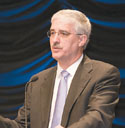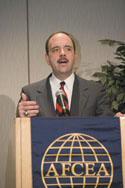Data Fusion Secures The Nation's Borders
 |
| Michael P. Jackson, deputy secretary, U.S. Department of Homeland Security (DHS), explains the department’s priorities, which include managing border security, at the Homeland Security 2007 conference. |
Information is a key weapon for combating an illusive and a decentralized enemy. By collecting, analyzing and sharing data among key organizations, the
Collaboration was the subject of AFCEA International’s Homeland Security 2007 conference, “Intelligence and Information Fusion … Beyond Sharing,” held in
DHS Deputy Secretary Michael P. Jackson outlined the department’s priorities for the next two years and explained that the DHS is solidifying its operational procedures to provide the next president with a mature organization. As part of this process, the department is focusing on five key missions: protecting the nation from dangerous people, protecting
Citing examples of work in these key areas,
The DHS also is taking steps to safeguard the nation against shipments of dangerous goods by expanding its ongoing Secure Freight container tracking program. The effort’s next phase will examine the use of data mining techniques to track containerized cargo before it reaches
 |
| Dale W. Meyerrose (l), associate director of national intelligence, chief information officer, Office of the Director of National Intelligence, and Charles Allen, assistant secretary for intelligence and analysis, chief intelligence officer, DHS, discuss advances in information sharing and networking. |
Allen noted that the DHS is a full partner with the
Dale W. Meyerrose, associate director of national intelligence and chief information officer, Office of the Director of National Intelligence, discussed his experiences with information sharing. Meyerrose outlined the steps taken to achieve information sharing, such as the creation of Intelink, which serves as a gateway between the secret Internet protocol router network and intelligence agencies. He added that he also intends to streamline the thousands of tools and systems in use on Defense Department networks by putting sunset clauses on them and reducing the number to about 14 applications.
Members of the DHS and the Federal Bureau of Investigation (FBI) discussed fusion centers and how their respective agencies use them. Lora Becker, director, DHS Federal State and Local Threat Reporting and Assessments Coordination Group, explained that her group’s mission is to facilitate distribution of terrorism-related data to state, federal and local agencies. She noted that her group follows three guidelines: sending alerts and warnings to locations in the
A key goal for fusion centers entails communicating with a national information-sharing group, said Michael Mines, FBI deputy director for intelligence. He offered that the bureau currently has more than 100 analysts and 50 special agents attached to fusion centers nationwide. Mines observed that fusion centers cover all types of crimes, whereas terrorism centers cover only incidents specifically related to terrorist activities. But he added that a need exists to share a variety of other crime-related information because this data often links back to terrorism suspects.
Defending the nation’s vital computer infrastructure was the topic of the luncheon speech by Dr. Edward G. Amoroso, chief security officer for AT&T. Amoroso argued that homeland security organizations are wasting time diverting resources and funds to fight spam. To defend networks against attack, firewalls and other types of intrusion detection systems must become more centralized and move away from the edges of the network where they now reside. He closed by noting that consumers tolerate software deficiencies and carrier issues that they do not tolerate in other products.
Information fusion is protecting the borders of the
As organizations implement new technologies, the panelists explained, they also face new challenges. Frank Moss, the U.S. State Department’s deputy assistant secretary of consular affairs and passport services, allowed that it may be easy to make the borders physically secure, but that the security must be accomplished in a way that is useful to the
DHS Chief Information Officer Scott Charbo noted that information sharing, intelligence, interoperability, fusion centers, communications, cybersecurity and research and development all relate to each other. DHS’ mission is to apply these capabilities as an entire package, rather than individually. Charbo admitted that the department has made some mistakes, but he added that the organization is synchronizing its information- sharing architectures with its mission by targeting 15 areas for improvement in 2007.
Rear Adm. Jay Cohen, USN (Ret.), undersecretary for science and technology, DHS, said that the department’s science and technology objectives must include accelerating the delivery of capabilities to fill technology gaps; establishing a team to give the
Science and technology investment portfolios comprise four levels: product transition for equipment that can be fielded within the next three years; innovative capabilities, which includes technologies that will be available in the next one to five years; basic research to lay the groundwork for capabilities that will require more than eight years to develop; and general investments that fund technologies in all of these categories.
The government agencies’ interoperability report card that the DHS issued in December 2006 (SIGNAL Connections, January 2007) identifies governance rather than technology as the barrier to achieving interoperability between systems, Adm. Cohen said. He said the department’s test, evaluation and standards sector will closely verify that solutions perform as promised, adding that the department “will not buy junk.” For example, the department tested products purported to identify chemicals used to build liquid explosives and found half of them to be ineffective.
Agencies at all levels of government face challenges when solving first responder interoperability issues. Panelist Paul J. Cosgrave, commissioner and chief information officer, Department of Information Technology and Telecommunications,
When the connection was stabilized, Cosgrave said that interoperability is his first priority, and although the city has made much progress in this area, a lot of work remains. “Interoperability first involves people being willing to talk to each other so the responsibilities are clear about who does what,” he said. To ensure consistent communications,
 |
| George Foresman, then DHS undersecretary for preparedness, speaks about the department’s present and future, noting that issues such as information fusion and border security are not new but work remains to be done to safeguard the nation and its infrastructure against present and future threats. |
“Information fusion and intelligence sharing are not new; border security is not new; national infrastructure protection is not new. But what we have today is nothing compared to the threats the country will face five years from now,” Foresman said. “We knew what we needed to implement, and we did it. But are we paying enough attention and time to what’s coming?”
Gregory Garcia, assistant secretary of cybersecurity and telecommunications, DHS, emphasized that risk management is as important in cyberspace as it is in physical national security. His organization’s strategic priorities include preparation and deterrence as outlined in the National Infrastructure Protection Plan; development of response plans that include the national computer emergency readiness teams; and enhancement of public awareness. To achieve its goals, DHS’ cybersecurity section established the Office of Emergency Communications in March and is working to raise awareness throughout all government agencies. Garcia emphasized the importance of coordinating cybersecurity efforts throughout the government saying, “We’re too interdependent to work independently in this area.”
Larry Clinton, chief operations officer, Internet Security Alliance, stated that the
In response to an audience question regarding government’s and industry’s state of preparedness for a cyberattack, panelist Lt. Gen. Al Edmonds, USAF (Ret.), president and chief executive officer, Edmonds Enterprise Services, said that companies are taking care of their own information systems because their financial success depends on it. However, companies do not trust the government, so they do not share information. As DHS matures, this situation will improve, he predicted.




Comments